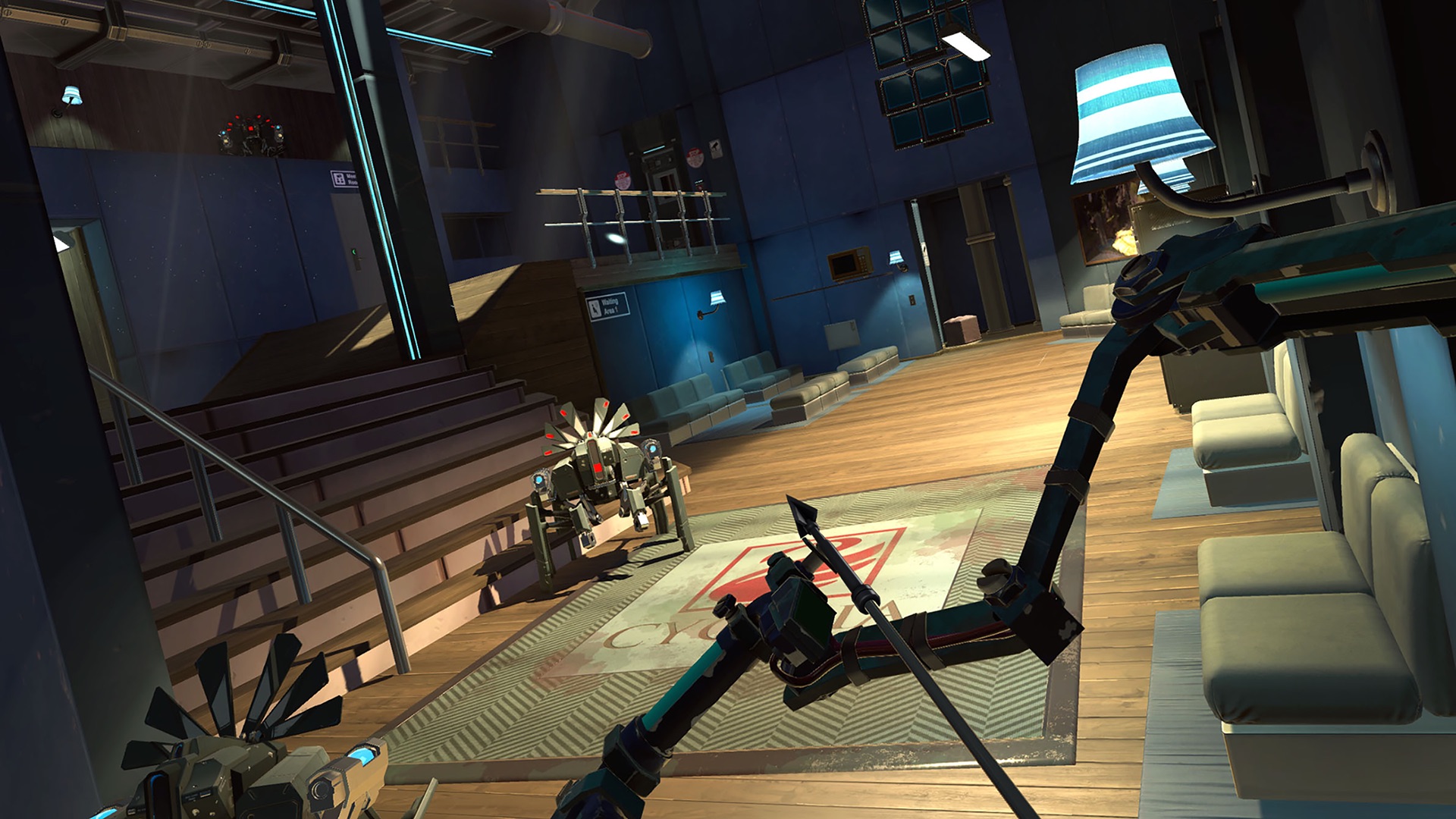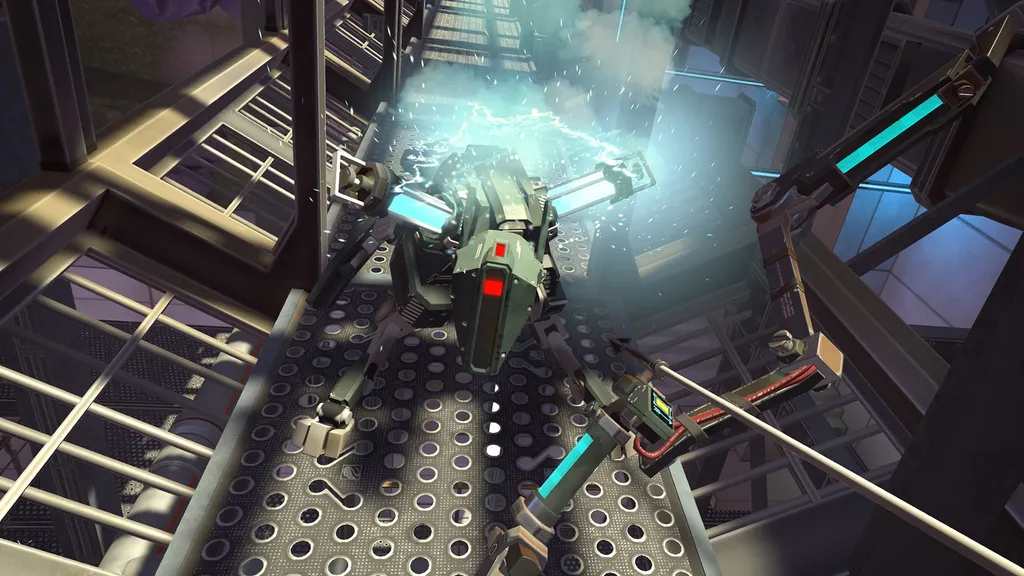From frantically firing your bow and arrow to traipsing through an impossibly twisted world in wonder, Apex Construct is a great example of how far VR development has come in the past two years. This is a game that understands what makes immersive action tick; throwing your headset from one side to the other to dodge incoming fire while taking the time and care to aim your own shots often imbues the movie star satisfaction so many VR games aim to provide.
But, just much as it demonstrates how far we’ve come, Apex Construct is also a great case study for how much further we have to go, too.
On paper, everything about this debut from Stockholm-based Fast Travel Games seems like a recipe for success. Take one of VR’s most tried and true mechanics, firing a bow and arrow, and build a four to five-hour adventure around it, allowing you to actually step into the post-apocalyptic setting we’re so used to seeing in games and fight robotic drones as if your life depended on it.
And, in practice, Apex Construct gets a lot of this very, very right. From the moment you begin it’s clear that this is a ‘full’ VR game. You play as an unnamed protagonist summoned into the real world by an experimental AI named Fathr and pair up to defeat a rogue program named Mothr. Across six environments that are smartly reused over the campaign you explore the conflict between these two advanced beings as you journey through what remains of the facility in which they were created.
Mothr has an army on her side; a series of spider-like robots that shoot dodgeable and blockable energy blasts and will later spawn energy shields and even teleport short distances to throw you off balance. They’re dispatched with a trusty bow and arrow that comes in three flavors: standard arrows have infinite ammo, shock arrows temporarily stun but have limited use before they recharge, as do exploding arrows that deal delayed but powerful damage.
When it gets it right, Apex Construct’s combat is often immersive and thrilling. Long distance battles in which you trade shots between quick dodges and blocks with a limited-use energy shield are often tense affairs that offer quite a challenge. Health doesn’t rejuvenate but instead must be regained by drinking soft drink cans acquired from vending machines or, if you’re lucky, found in the real world. It’s refreshing to play something that isn’t so forgiving (three or four hits on Normal difficulty will see you off) and actually puts some threat on the line, though this also serves as one of the game’s biggest frustrations.

Most enemies you kill in Apex Construct will give you experience points used to upgrade your weapons and shield, which is utterly essential for completing later missions. You’ll also find large XP drops hidden in secret areas. However, should you die, you’ll lose all the XP you’ve gained in the level thus far. And this isn’t a Dark Souls rip-off; those points are gone for good. The game encourages you to head back to a hideout to bank earned points, but doing so means starting the current level from scratch. It’s hugely irritating to reach the final encounter in a level with limited health, die, and then come back to the hideout nearly empty-handed.
And, a fair amount of the time, you won’t feel like death is actually your fault. On PSVR, the game has great locomotion options, but when you’re aiming your bow and arrow you won’t be able to move around as much, given that both teleportation and free locomotion on PlayStation Move is directed by where you’re aiming the controller. Having to stay rooted to the spot to make your shot is unnervingly restrictive, especially when the erratic drones decide to rush past you and shoot you in the back without giving you much time to react (a melee attack would have been hugely appreciated). Games like Farpoint purposfully keep enemies in front of you as you play and Apex Construct shows you why; it can make combat feel more like a hassle on PSVR.
Things are much improved on PC, though, provided you have 360 degree tracking. Without it, the Rift version still offers some of these niggles, but with a three sensor setup or a Vive/Windows VR headset the combat becomes much more manageable and immersive. Following an enemy with your bow trained on it as it circles around you really roots you in the moment, and smooth locomotion works much better on Touch or the Vive and Windows wands. That said, it can still be a chore to maintain pace with the robots that have little care for how exhausting it can be to chase them down as they scurry about the environments.
For every teeth-grinding encounter, though, there’s another that reminds you how much fun Apex Construct is at its best, like when you can hold hordes of enemies at bay with shock arrows fired into puddles of water for area attacks. For every mind-numbing objective like an insta-death stealth mission (yes there really is one) there are nail-biting defense levels and even a pretty entertaining boss battle that are only offset by the frustration that comes from failure.
Much of the game’s enjoyment comes from outside of the combat, anyway. Though potential twists aren’t subtly teased so much as directly telegraphed to you from the start, the story manages to grab you thanks to the detailed world and the gravely hurt you can detect in Fathr’s Ultron-like voice. Exploring the facility and uncovering notes that fill in more puzzle pieces is often intriguing, even if there are a few too many moments in which you’ll have to search for a password to open a locked door, especially within the first few hours.
Even in these quieter moments, though, there are perhaps unavoidable nitpicks to take you out of the immersion. The free locomotion, for example, shows clear signs of late-development implementation, as you’ll often get stuck on geometry or find yourself ascending into the air when walking past something like a chair. Fortunately, teleportation is just a button press away, but I found myself switching between the two so often out of necessity that traversing the world felt more finicky than it should.
The same goes for interacting with the game’s computers, which ask you to press enlarged keyboard keys. The lack of haptic feedback, though, often had me pressing the wrong keys and the game’s camera resets if you lean too close to a surface, meaning I’d often jolt backward as I was trying to type or read. These might sound like small nitpicks, but they happen far too often and demonstrate some of the more intricate details of VR game design that developers still need to nail to keep players fully immersed at all times.
Still, it was never so overwhelming that I didn’t want to make it through to the end of the adventure and even remain in it once I’d beaten the last level. Apex Construct has some light Metroidvania elements that allow you to revisit older levels with updated inventory to open new doors and uncover more of the story, which is something I fully intend on doing.
Apex Construct on PSVR has a few too many niggling issues to be considered truly great but still remains a VR adventure you should absolutely undertake. It’s a rare chance to jump into an expansive journey and become a part of an engrossing world, warts and all. It proves that VR developers can now deliver the adventures we dreamed of having when we first picked up our headsets. The next step is to refine them enough to keep us believing we’re really there. For now, though, Apex Construct will do just fine.
Thanks to improved tracking and sharper visuals, the PC version of Apex Construct is a step up from its console counterpart. With full 360 degree turning, combat is a much smoother experience and smooth locomotion on the controller’s navigation options feels much better. While many of the original issues we cited still remain, they’re much more manageable when you’re not fighting the limitations of the platform. If you’re looking to play Apex Construct, PC is definitely the way to go.
Apex Construct ia now available on PSVR, Oculus Rift, HTC Vive and Windows VR. Read our Game Review Guidelines for more information on how we arrived at this score.


























